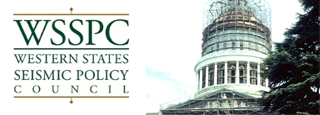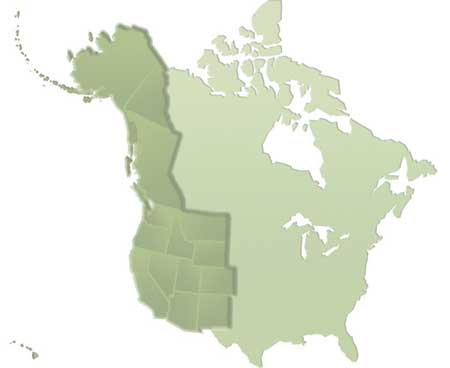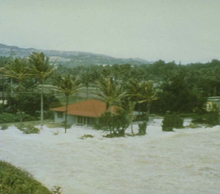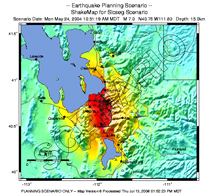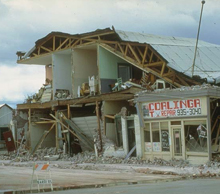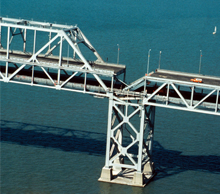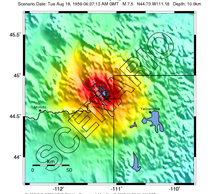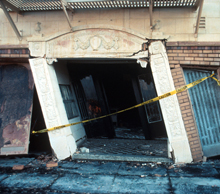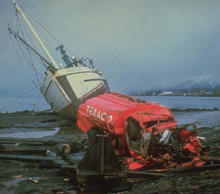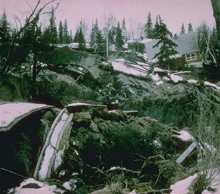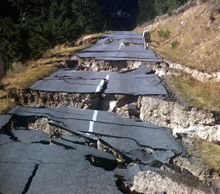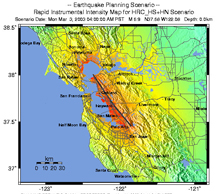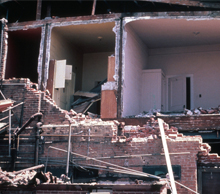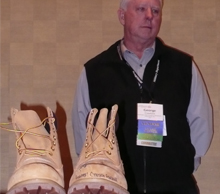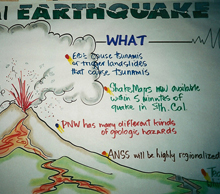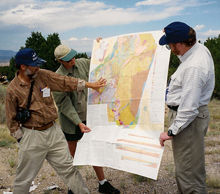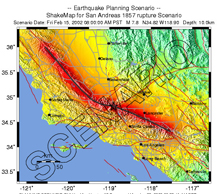California Earthquake Hazards Mitigation Legislation
(CA‐1) Field Act (Education Code‐§17281, et seq.): In 1933, one month after the Long Beach Earthquake destroyed 70 schools, seriously damaged 120 others, and caused minor damaged to 300 more, California passed the Field Act to ensure seismic safety in new public schools. The Act establishes regulations for the design and construction of K‐12 and community college buildings. The Division of the State Architect within DGS enforces the Field Act.
(CA‐2) Riley Act: Following the 1933 Long Beach Earthquake, the state also passed the Riley Act, which requires local governments to have building departments that issue permits for new construction and alterations to existing structures and conduct inspections. Permit fees paid by building owners generally fund the work of local building departments. The Act also set minimum seismic safety requirements that have since been incorporated into all building codes.
(CA‐3) Garrison Act: Requires school boards to assess building safety of pre‐Field Act schools, ordered modernization of non‐field act compliant structures.
(CA‐4) Strong Motion Instrument Act (Public Resources Code§§2700‐2709.1): The state passed the Strong Motion Instrumentation Act in 1972 in response to the extensive damage to buildings and bridges caused by the 1971 San Fernando Earthquake. The earthquake highlighted the need for more data on strong ground shaking during earthquakes and on the response of structures to the shaking. The Act established a statewide network of strong motion instruments to gather vital earthquake data for the engineering and scientific communities. Data obtained from the strong motion instruments is used to recommend changes to building codes, assist local governments in the development of their general plans, and help emergency response personnel in the event of a disaster.
(CA‐5) Seismic Safety General Plan Element (Government Code § 65302): Requires city and county plans to include seismic safety elements.
(CA‐6) Alquist‐Priolo Earthquake Fault Zoning Act (Public Resources Code § 2621‐2630): The state passed the Alquist‐Priolo Earthquake Fault Zoning Act in 1972 to mitigate the hazard of surface faulting to structures built for human occupancy. The law was another response to the 1971 San Fernando Earthquake, which produced extensive surface fault ruptures that damaged numerous homes, commercial buildings, and other structures. The Act’s main purpose is to prevent the construction of buildings used for human occupancy on the surface trace of active faults. Before issuing building permits, cities and counties must require a geologic investigation to ensure that proposed buildings will not be constructed across active faults. Proposed building sites must be evaluated by a licensed geologist. If an active fault is found, a structure for human occupancy cannot be placed over the trace of the fault.
(CA‐7) Alfred E. Alquist Hospital Facilities Seismic Safety Act (Health and Safety Code§129675): The loss of emergency functions and hospital collapses due to the 1971 San Fernando Earthquake prompted passage of the Hospital Seismic Safety Act of 1973. Regulates the design, construction and alteration of hospitals; set seismic safety standards for new hospitals; created an advisory Hospital Building Safety Board. Office of Statewide Health Planning & Development enforces this Act.
(CA‐8) Seismic Safety Commission Act (Business and Professions Code §1014): The 1971 San Fernando Earthquake highlighted weaknesses in California’s earthquake risk management policies. To address these weaknesses, in 1975 the state legislature created the independent California Seismic Safety Commission (CSSC) to provide a consistent earthquake policy framework for the state. The mission of CSSC is “to provide decision makers and the general public with cost‐effective recommendations to reduce earthquake losses and expedite recovery from damaging earthquakes.” The commission is also responsible for implementing the California Earthquake Hazards Reduction Act, which requires CSSC to “prepare and administer a program setting forth priorities, funding sources, amounts, schedules, and other resources needed to reduce statewide earthquake hazards.”
(CA‐9) Earthquake Hazard Reduction Program (Senate Bill 1279): Directs California Seismic Safety Commission to assess policy and program implications of earthquake prediction and to develop seismic safety program and financing plan for the state.
(CA‐10) Alquist Hospital Facilities Seismic Safety Act of 1983 (Health and Safety Code §§130000‐130070): Requires design and construction standards for hospitals; requires that after Jan. 1, 2008 any general acute care hospital building determined to be at potential risk of collapse or poses a risk of significant loss of life be used only for nonacute care.
(CA‐11) California Earthquake Hazards Reduction Act of 1986 (Government Code §8870, et seq.): After the 1985 Mexico City Earthquake, in 1986 California passed the Earthquake Hazards Reduction Act, which called for a coordinated state program to implement new and expanded activities to significantly reduce earthquake threat. The program is coordinated by California Seismic Safety Commission, which is required to specify priorities, funding sources and amounts, schedules, and other resources. Although historically funded by the state general fund, since the 2003‐2004 fiscal year, the program was funded by fees imposed on property insurance companies.
(CA‐12) Un‐reinforced Masonry Building Law (Government Code §§ 8875‐8875.10): In response to the 1983 Coalinga Earthquake, in 1986 the state legislature enacted the Un‐reinforced Masonry Building Law, which requires local governments in high seismic regions of California to inventory un‐reinforced masonry buildings, establish mitigation programs, and report progress to the CSSC. As of 2003, 251 local governments have established programs and 16,761 buildings have either been retrofitted or demolished. Cities and counties rely on a variety of funding sources, including building permit fees, to pay for these programs. Some local programs offer financial, planning, and zoning incentives to building owners for retrofit. The CSSC periodically reports on the progress made by local programs in a publication entitled Status of the Un‐reinforced Masonry Building Law, most recently in 2003.
(CA‐13) Essential Services Building Seismic Safety Act (Health and Safety Code §16000): In 1986 the state passed the Essential Services Building Seismic Safety Act to require enhanced regulatory oversight by local governments during the design and construction of new essential service facilities, such as fire and police stations and emergency communications and operations facilities. The Division of the State Architect within DGS enforces this Act. Pursuant to the Act, the Division of the State Architect within DGS adopted regulations that apply to the construction of all new essential services buildings (California Code of Regulations, Title 24, Part 1, §4‐201 to §4‐249). There are no statewide regulations for evaluating and retrofitting locally regulated essential services buildings that existed prior to 1986 except for unreinforced masonry buildings in some jurisdictions. Some local governments and state agencies have voluntarily retrofitted or replaced their vulnerable buildings.
(CA‐14) Katz Act (Education Code §§35295‐35297): Requires all private schools to develop disaster plans and an earthquake emergency procedure system.
(CA‐15) Bridge Seismic Retrofit Program (Senate Bill 2104): Requires CalTrans to prepare an inventory of all state‐owned bridges which require strengthening or replacement to meet seismic‐safety standards, and prepare a plan and schedule for completion. Note: Since the 1971 San Fernando Earthquake, CalTrans has been authorized to seismically retrofit vulnerable state and local bridges. Phase 1 consisted of retrofitting 1,039 state‐owned single‐ and multiple‐column bridges at a cost of $815 million. Phase 2 consisted of retrofitting the remaining 1,364 multiple‐column state bridges at a cost of approximately $2 billion. Approximately $1.5 billion is being spent to replace major non‐toll bridges and $4.6 billion for major toll bridge retrofits and replacements. Replacement costs include significant non‐seismic upgrades. Costs for retrofitting 1,212 locally owned bridges are expected to be approximately $1 billion. Funds come from the State Transportation Improvement Fund, the State Highway Account, FEMA public assistance, sales tax increments, and gasoline taxes.
(CA‐16) Earthquake Safety and Public Buildings Rehabilitation Bond Act of 1990 (Prop 122 & Government Code §§ 8878.50‐8878.52): Proposition 122 was passed by voters in June 1990 after the 1989 Loma Prieta earthquake revealed vulnerabilities to state‐owned and essential services buildings. The bond measure authorized the state to issue $300 million in general obligation bonds for the seismic retrofit of state and local government buildings ($250 million for state‐owned buildings and $50 million for partial financing of local government essential services facilities). The Seismic and Special Programs Section of DGS’ Real Estate Services Division administers Proposition 122 grant programs.
(CA‐17) Seismic Hazards Mapping Act (Public Resources Code §§ 2690‐2699.6): The Seismic Hazards Mapping Act, passed in 1990, directs the Department of Conservation to identify and map areas prone to liquefaction, earthquake‐induced landslides, and amplified ground shaking. The purpose of the Act is to reduce the threat to public safety and to minimize the loss of life and property by identifying and mitigating these seismic hazards. The Act requires geotechnical investigations to identify hazards and formulate mitigation measures before permitting most developments within mapped Zones of Required Investigation.
(CA‐18) Health & Safety Code § 1226.5: Establishes seismic safety standards for ambulatory surgical centers; requires fixed medical equipment (floor roof or wall mounted) to be installed using services of licensed architect or structural engineer; and requires inspection every five years.
(CA‐19) Health and Safety Code §§ 19210‐19214: Requires new and replacement water heaters to be braced and anchored.
(CA‐20) Executive Order D‐86‐90: Requires CalTrans to prepare plan to retrofit transportation structures; requests UC and requires CSU to give priority consideration to seismic safety in allocation of funds for construction projects.
(CA‐21) California Earthquake Authority (Insurance Code §§ 10089.5‐10089.54): Creates the California Earthquake Authority and authorized CEA to issues policies of basic earthquake insurance.
(CA‐22) Education Code§17317: Requires Department of General Services to conduct inventory of public school buildings that are concrete tilt‐up or have nonwood frame walls that do not meet requirements of 1976 UBC by Dec. 31, 2001.
(CA‐23) Government Code §8587.7: Program Requires Office of Emergency Services, in cooperation with State Department of Education, Department of General Services and the Seismic Safety Commission to develop an educational pamphlet for use by K‐14 personnel to identify and mitigate risks posed by nonstructural earthquake hazards.
(CA‐24) Health and Safety Code §§19180‐83 & §§19200‐05: Authorizes local governments to adopt ordinances requiring installation of earthquake sensitive gas shutoff devices in buildings due to motion caused by an earthquake; allows Division of the State Architect to establish a certification procedure for installation.
(CA‐25) Streets & Highways Code §188.4: Program Authorizes retrofit of state‐owned toll bridges using seismic toll surcharge.
(CA‐26) Highway Safety, Traffic Reduction, Air Quality, and Port Security Bond Act of 2006 (Proposition 1B, Government Code §8879.23(i)): 2006 Essential facility seismic safety Program Provides $125 million funding for seismic retrofit work on local bridges, ramps, and overpasses; establishes Local Bridge Seismic Retrofit Account.
(CA‐27) California Emergency Services Act (Government Code §8550): The California Emergency Services Act provides the legal authority for emergency management and the foundation for coordination of state and local emergency response, recovery, preparedness, and mitigation activities throughout California.
(CA‐28) Disaster Recovery Reconstruction Act, Government Code §8877.1: The Legislature finds and declares that the impact of the Mexico City earthquake disaster of September 19, 1985, has rendered more cogent and compelling the findings of the Legislature set forth in Section 8870, particularly subdivision (c) thereof, and heightened the need for authority for local agencies to engage in effective pre‐event and post‐event activity to accomplish those goals set forth in paragraph (4) of subdivision (b) of Section 8872. It is the intent of this chapter to provide that authority. 8877.3. It is the purpose of this chapter to authorize, guide, and otherwise enable cities, counties, and other entities to prepare in advance of a disaster, such as a devastating earthquake, for the expeditious and orderly recovery and reconstruction of the community or region. Each city, county, or other local subdivision of the state, may prepare, prior to a disaster, plans and ordinances facilitating the expeditious and orderly recovery and reconstruction of the area under its jurisdiction, should a disaster occur. These plans and ordinances may include any of the following: An evaluation of the vulnerability of specific areas under its jurisdiction to damage from a potential disaster, together with streamlined procedures for the appropriate modification of existing general plans or zoning ordinances affecting those areas after a disaster. A contingency plan of action and organization for short‐term and long‐term recovery and reconstruction to be instituted after a disaster.
(CA‐29) Economic Disaster Act of 1984, Government Code §8695: The Legislature finds and declares that the disaster response of state agencies does not adequately focus on the economic impact of a natural disaster on the business community. 8696. It is the purpose of this chapter to institutionalize the planning and response of state agencies to disasters in order to reduce economic hardship stemming from these disasters to business. Upon the completion of the emergency phase and the immediate recovery phase of a disaster, appropriate state agencies shall take actions to provide continuity of effort conducive to long‐range economic recovery. The Director of the Office of Emergency Services shall invoke the assignments made pursuant to Section 8595, specifying the emergency functions of each agency or department. The Director of the Office of Emergency Services, in executing the purposes of this chapter, shall establish appropriate task forces or emergency teams to include concerned elements of federal, state, and local governments and the private sector.
(CA‐30) Natural Disaster Assistance Act, Government Code §8680: Provides state financial assistance for recovery efforts to counties, cities and/or special districts after a state disaster has been proclaimed. The applicant must incur a minimum aggregate total damage cost of $2,500 state share for each declared disaster for costs to be eligible under CDAA. A local agency must submit a Project Application (OES 126) to the California Emergency Management Agency (Cal EMA) within 60 days after the date of a local proclamation. When filing an application for assistance, an applicant may attach a List of Projects (OES 95). Applicants are also required to have on file with Cal EMA, a resolution designating an authorized representative (OES 130) for each disaster. Cal EMA coordinates the state’s response to major emergencies in support of local government. The primary responsibility for emergency management lies with local government. Local jurisdictions first use their own resources, and as they are exhausted, obtain more from neighboring cities and special districts, the county in which they are located, and other counties throughout the state through the Statewide Mutual Aid System. Cal EMA serves as the lead agency for mobilizing the State’s resources; it also maintains oversight of the State’s Mutual Aid System. During an emergency, Cal EMA coordinates the state’s response efforts. After a natural or man‐made event causes extensive damage and a state disaster has been declared, Cal EMA has the regulatory responsibility to act as the grantor for the California Disaster Assistance Act (CDAA). The CDAA program may be implemented as a “stand alone” funding source following an Cal EMA Agency Secretary’s Concurrence for a local emergency, or a Governor’s Proclamation when there is no federal declaration.
(CA‐31) Natural Hazards Disclosure Act, Civil Code §1102: This article applies to the transfer by sale, exchange, installment land sale contract , lease with an option to purchase, any other option to purchase, or ground lease coupled with improvements, of any real property described in subdivision or residential stock cooperative, improved with or consisting of not less than one nor more than four dwelling units. NATURAL HAZARD DISCLOSURE STATEMENT‐The transferor and his or her agent(s) or a third‐party consultant disclose the following information with the knowledge that even though this is not a warranty, prospective transferees may rely on this information in deciding whether and on what terms to purchase the subject property. The following are representations made by the transferor and his or her agent(s) based on their knowledge and maps drawn by the state and federal governments.
This information is a disclosure and is not intended to be part of any contract between the transferee and transferor. The disclosures must indicated if the real property lies within any of the following hazardous areas: A SPECIAL FLOOD HAZARD AREA (Any type Zone “A” or “V) designated by FEMA; AN AREA OF POTENTIAL FLOODING shown on a dam failure inundation map; A VERY HIGH FIRE HAZARD SEVERITY ZONE; A WILDLAND AREA THAT MAY CONTAIN SUBSTANTIAL FOREST FIRE RISKS AND HAZARDS; AN EARTHQUAKE FAULT ZONE; and/or A SEISMIC HAZARD ZONE.
(CA‐32) Planning and Zoning Law, Government Code 65000: Establishes the protocols and authority for land‐use, planning and zoning laws for local jurisdictions throughout the state. The Legislature finds and declares that California’s land is an exhaustible resource, not just a commodity, and is essential to the economy, environment and general well‐being of the people of California. It is the policy of the state and the intent of the Legislature to protect California’s land resource, to insure its preservation and use in ways which are economically and socially desirable in an attempt to improve the quality of life in California. The Legislature also finds that decisions involving the future growth of the state, most of which are made and will continue to be made at the local level, should be guided by an effective planning process, including the local general plan, and should proceed within the framework of officially approved statewide goals and policies directed to land use, population growth and distribution, development, open space, resource preservation and utilization, air and water quality, and other related physical, social and economic development factors. 65030.2. Costs and benefits of growth. It is further the policy of the state and the intent of the Legislature that land use decisions be made with full knowledge of their economic and fiscal implications, giving consideration to short‐term costs and benefits, and their relationship to long‐term environmental impact as well as long‐term costs and benefits. The Legislature further finds and declares that recommendation, continuous evaluation and execution of statewide environmental goals, policies and plans are included within the scope of the executive functions of the Governor and responsibility for assuring orderly administration of this process within state government should be assigned to a governmental unit reporting directly to the Governor.
Information taken from the Washington State Seismic Mitigation Policy Gap Analysis: A Cross-State Comparison, by Scott B. Miles, Ph. D. and Brian D. Gouran, L.G.
